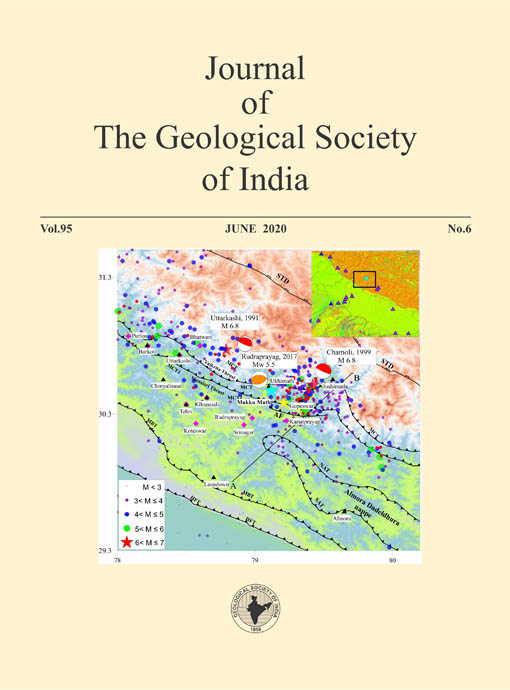Review on the Role of Hydrocarbon Resources in India's Energy Security and Climate Goals
DOI:
https://doi.org/10.1007/s12594-020-1482-4Keywords:
No Keywords.Abstract
In India, effective use of hydrocarbon fuels are essential for achieving energy security, economic growth, climate goals and to bridge the implementation delays in the renewable energy sector. Based on the published data, the paper reviews the role of hydrocarbon resources in the Indian energy sector and the need for an innovation-centered ecosystem in the areas of clean-coal usage, natural gas, sequestration and utilizing unconventional hydrocarbon resources.Downloads
Metrics
Issue
Section
Downloads
Published
How to Cite
References
Annual report 2017-18, Ministry of Petroleum and Natural Gas. http://petroleum.nic.in/sites/default/files/APR_E_1718.pdf.
CCS (2017) deployment in the context of regional developments in meeting long term climate change objectives, ss Technical Report, 2017-07.
Central electricity authority (2019) Executive summary of Indian power sector, Ministry of Power, File No.CEA-CH-14-11/4/2018-Coordination Division FDI in the coal mining sector in India, 2020 https://mines.gov.in/ViewData/Details?mid=1353&catID=56.
CCS Readiness iIndex (2018). Is the world ready for carbon capture and storage?, the carbon capture and storage readiness index2018. http://decarboni.se/sites/default/files/publications/202108/ccs-readiness-index-2018global-ccs-institute-2018digital.pdf.
Harendra Kumar (2018) Energizing India, Overall energy scenario of India till 2047, A joint report of NITI Aayog and IEEJ.
IESS, N. (2015) Aayog: India Energy Security Scenarios, 2047, NITI Aayog, Govt of India. Version 2.0. http://www.indiaenergy.gov.in/docs/Hand%20Book.pdf.
International Energy Agency (2015b) India Energy Outlook, World Energy Outlook Special Report.
Jasan IGCC project, http://www.airproducts.com/∼/media/Files/PDF/microsites/jazan/JazanIGCCESIAVol1091219v22.pdf?la=en.
Míguez, J.L., Porteiro, J., Pérez-Orozco, R. and Gómez, M.í. (2018) Technology Evolution in Membrane-Based CCS. Energies, v.11(11), pp.3153.
Natural Resources Defence Council (NRDC) (2015) The Paris Agreement on Climate Change, https://www.nrdc.org/sites/default/files/paris-climate-Agreement-IB.pdf.
Offshore Energy Outlook (2019) World Energy Outlook Series https://www.iea.org/.
Phillips, J.N., Booras, G.S. and Marasigan, J. (2017) The History of Integrated Gasification Combined-Cycle Power Plants. In: ASME Turbo Expo 2017: Turbomachinery Technical Conference and Exposition. American Society of Mechanical Engineers Digital Collection, Charlotte, GT2017-64507.
Ranjan, R. (2019) Assessing the impact of mining on deforestation in India. Resources Policy, v.60, pp.23-35.
Rosner, F., Chen, Q., Rao, A., Samuelsen, S., Jayaraman, A. and Alptekin, G. (2019) Thermo-economic analyses of IGCC power plants employing warm gas CO2 separation technology. Energy, v.185, pp.541-553.
Sheps, K.M., Max, M.D., Osegovic, J.P., Tatro, S.R. and Brazel, L.A. (2009) A case for deep-ocean CO2 sequestration. Energy Procedia, v.1(1), pp.4961-4968.
Sleipner Fact Sheet: Carbon Dioxide Capture and Storage Project. https://sequestration.mit.edu/tools/projects/sleipner.html
UNEP DTU Partnership (2016) Center on Energy, Climate and Sustainable Development, http://www.cdmpipeline.org/cdm-projects-region.htm#7.
Union of Concerned Scientists (UCSUSA) (2019) https://www.ucsusa.org/resources/each-countrys-share-co2-emissions.
Vedachalam, N., Ramesh, S., Umapathy, A. and Ramadass, G. A. (2016). Importance of gas hydrates for India and characterization of methane gas dissociation in the Krishna-Godavari basin reservoir. Marine Tech. Soc. Jour., v.50(6), pp.58-68.
Vedachalam, N., Srinivasalu, S., Rajendran, G., Ramadass, G.A., and Atmanand, M.A. (2015) Review of unconventional hydrocarbon resources in major energy consuming countries and efforts in realizing natural gas hydrates as a future source of energy. Jour. Natural Gas Sci. Engg., v.26, pp.163-175.
Vedachalam, N., Surendar, S. and Srinivasalu, S. (2017) An assessment of decarbonization in the strategic Indian electricity generation sector. The Electricity Jour., v.30(5), pp.47-53.
Waite, W.F., Santamarina, J.C., Cortes, D.D., Dugan, B., Espinoza, D.N., Germaine, J., ... and Soga, K. (2009) Physical properties of hydrate bearing sediments. Rev. Geophys., v.47(4), DOI:10.1029/2008RG000279
Wang, Y., Nian, V., Li, H. and Yuan, J. (2018) Life cycle analysis of integrated gasification combined cycle power generation in the context of Southeast Asia. Energies, v.11(6), pp.1587. DOI:10.3390/en11061587.
Wangen, M., Gasda, S.E. and Bjí¸rnarå, T.I. (2016) Geomechanical consequences of large-scale fluid storage in the Utsira Formation in the North Sea. Energy Procedia, v.97, pp.486-493.

 N. Vedachalam
N. Vedachalam






